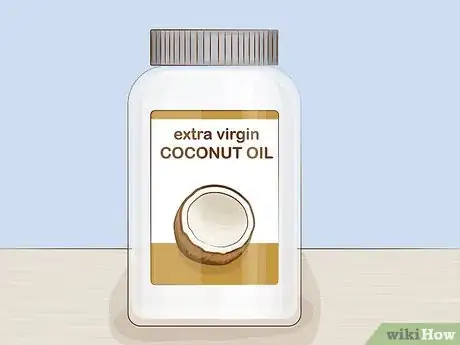This article was co-authored by wikiHow Staff. Our trained team of editors and researchers validate articles for accuracy and comprehensiveness. wikiHow's Content Management Team carefully monitors the work from our editorial staff to ensure that each article is backed by trusted research and meets our high quality standards.
wikiHow marks an article as reader-approved once it receives enough positive feedback. In this case, 93% of readers who voted found the article helpful, earning it our reader-approved status.
This article has been viewed 44,320 times.
Learn more...
If you prefer the taste of coconut, you can easily swap out vegetable oil for coconut oil. Some people also think coconut oil is healthier than vegetable oils, which often have artificial ingredients. Coconut oil is an appropriate substitute for both baking and cooking and can add a delicious tropical taste to dishes. With a few simple tweaks, most recipes can incorporate a dash of coconut oil over vegetable oil.
Steps
Using Coconut Oil in Baking
-
1Use a 1:1 ratio. In general, you don't need to change the amounts when swapping coconut oil for vegetable oil in a baking recipe. If a recipe calls for a cup of vegetable oil (240 mL), you can add a cup of coconut oil (240 mL) instead and it should still turn out fine.[1]
-
2Melt the coconut oil before use. Coconut oil is usually solid when you first purchase it. If you want to use it as a substitute for vegetable oil, it needs to be melted to a similar consistency.< Coconut oil will generally melt on its own if stored at 76 °F (24 °C). If it's not melted when you want to use it, simply set the jar in a bowl of hot tap water and let it sit until it melts.Advertisement
-
3Let the other ingredients come to room temperature. Coconut oil mixes best with room temperature ingredients. An hour or two prior to baking, set out ingredients like eggs and butter. This lets them reach room temperature before you bake with coconut oil.
Cooking with Coconut Oil
-
1Opt for coconut oil to balance bitter tastes. If you're cooking sweeter ingredients, like fruits or sweeter veggies like carrots, coconut oil may not be a great substitute. It has a sweet flavor, which can be overwhelming when mixed with sweeter foods. However, coconut oil can be great to use when you're cooking with bitter ingredients, such as broccoli, kale, or spinach. It can add a sweet flavor to balance out the bitterness.[2]
- When cooking sweeter ingredients, try substituting olive oil or something similar for vegetable oil.
-
2Fry meat and vegetables with coconut oil. Recipes frequently call for vegetable oil to cook things like vegetables or meat. If you want to use coconut oil instead, simply grease your pan with coconut oil instead of vegetable oil. It should work just as well in terms of preventing ingredients from sticking to the pan.[3]
-
3Substitute coconut oil for a tropical flavor. Coconut oil can be great for dishes like stir fries or curries, as it adds a mild tropical flavor. For a little flare on a traditional dish, like chicken and broccoli, cook with coconut oil over vegetable oil. You can also use coconut oil for marinades or salad dressings that call for vegetable oil.[4]
- For most recipes, you can use the same amount of coconut oil as vegetable oil.
-
4Go for extra virgin coconut oil for a stronger flavor. Coconut oil, like olive oil, comes in different varieties. If you love the taste of coconut oil, and want a dish with a strong flavor, go for extra virgin coconut oil. The flavor tends to hold up better during cooking.[5]
-
5Opt for refined or pressed coconut oil for a mild flavor. If you want the health benefits of coconut oil, but dislike the flavor, look for refined or pressed coconut oil. This does not have a taste or smell like other oils. It may be hard to find in stores, but it can be purchased online.[6]
Avoiding Common Mistakes
-
1Talk to your doctor about coconut oil if you have high cholesterol. The health effects of coconut oil are debatable, but some studies indicate it can raise cholesterol. If you already have high cholesterol, talk to your doctor before incorporating coconut oil into your diet.[7]
-
2Measure ingredients by weight over volume, if possible. If you have a kitchen scale, use it when baking. Weigh your vegetable oil and then measure out an equal amount of coconut oil. While measuring using measuring cups works well enough, it's generally best to substitute based on weight over volume.
-
3Avoid refrigerating coconut oil. Coconut oil usually needs to be melted if you're using it as a vegetable oil substitute. If kept in the fridge, coconut oil will harden. Each time you want to use it, you'll have to wait until it melts. If you frequently use coconut oil as a vegetable oil substitute, keep it in a kitchen cabinet over the refrigerator so it stays melted.
References
- ↑ http://www.swansonvitamins.com/blog/mackenzie-k/coconut-oil-cooking
- ↑ http://www.swansonvitamins.com/blog/mackenzie-k/coconut-oil-cooking
- ↑ https://downshiftology.com/simple-swaps-coconut-oil-vegetable-oil/
- ↑ http://www.swansonvitamins.com/blog/mackenzie-k/coconut-oil-cooking
- ↑ http://www.swansonvitamins.com/blog/mackenzie-k/coconut-oil-cooking
- ↑ https://kellythekitchenkop.com/coconut-oil-with-no-taste-or-smell/
- ↑ https://www.kitchenstewardship.com/faqs-on-coconut-oil-and-how-to-use-it/
































































